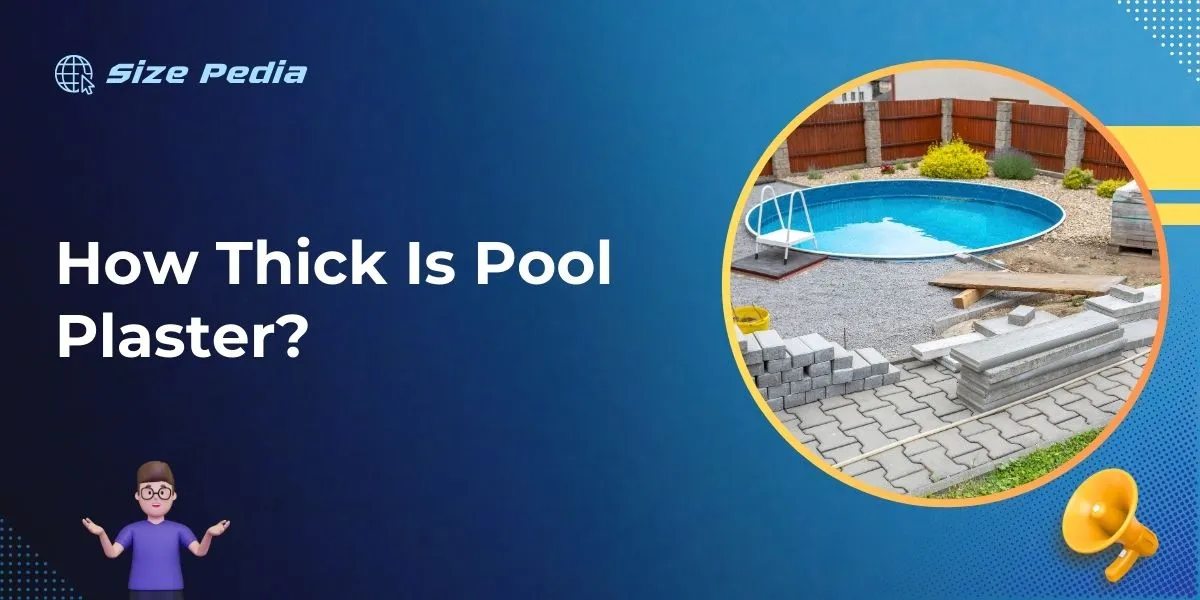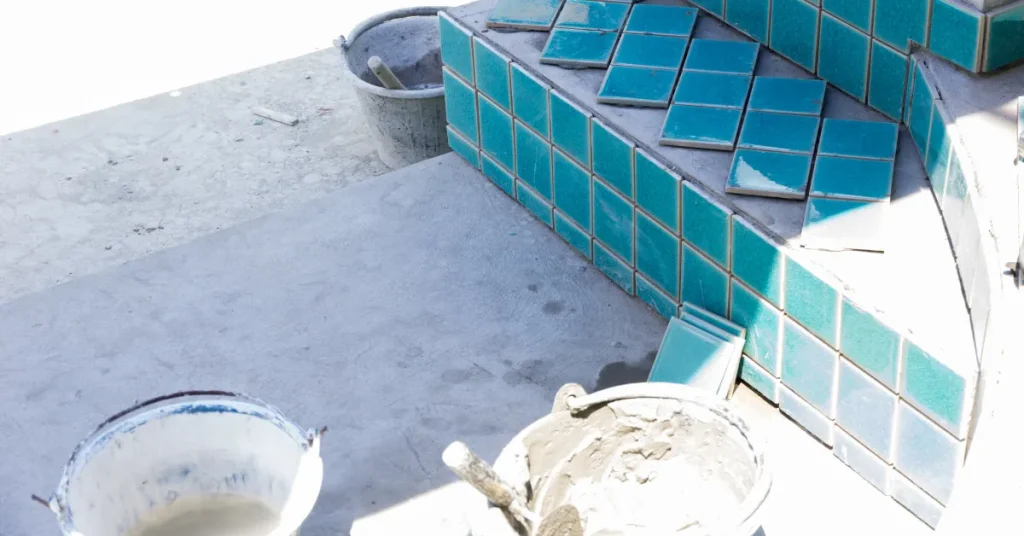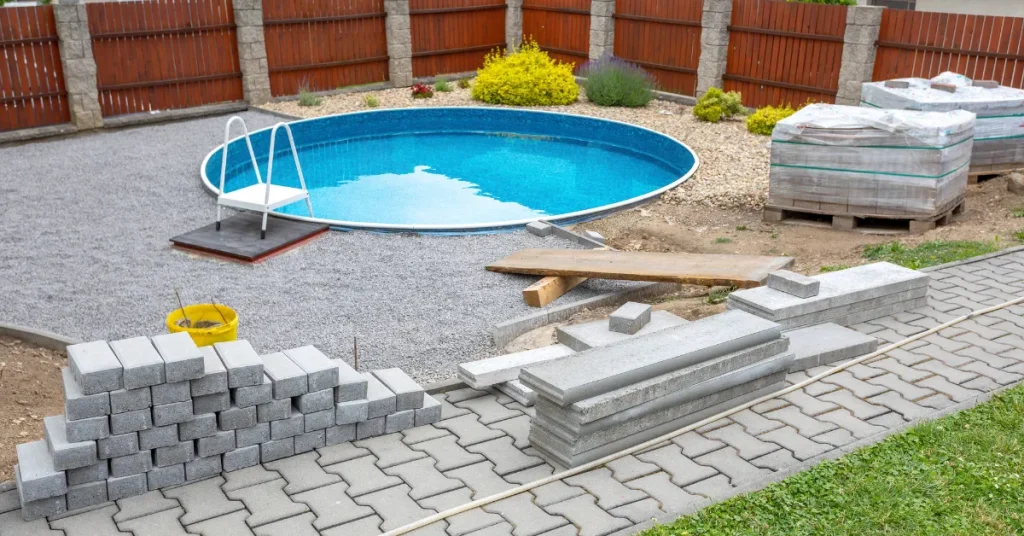Pool plaster typically has a thickness of 3/8 to 1/2 inch. This is about 10 to 12 millimeters.
Installing a new pool or refurbishing an existing one often involves the application of pool plaster to ensure a smooth, durable surface. This integral aspect of a pool’s construction is not only functional but also contributes to the overall aesthetics of your swimming area.
Properly applied pool plaster can guard against water leakage and surface damage, enhancing the longevity of the pool.
Homeowners and pool contractors alike prioritize the quality of plastering to maintain a safe and inviting pool environment.
Understanding the thickness of pool plaster is crucial for optimal outcomes, as it affects the finish’s resilience and the pool’s long-term integrity. This knowledge helps in accurate budget planning and scheduling maintenance for the pool’s plaster surface.

Peeling Back The Layers
Welcome to the heart of your swimming sanctuary: the pool plaster. Imagine peeling an onion, layer by layer, to reveal what’s at the core. With pool plaster, understanding these layers is key to a long-lasting, smooth swimming experience.
Let’s dive into the essentials and explore the critical role of thickness in the world of pool plaster.
Pool Plaster Essentials
Pool plaster is the final coating applied to the shell of a concrete pool. It serves as the waterproof barrier that stands between the pool structure and the water.
Comprising cement and marble dust or silica sand, the plaster is typically finished with a smooth texture.
Common types of pool plaster include:
- White Marble Plaster: Standard option offering a classic look
- Quartz Plaster: Enhanced durability with a variety of colors
- Polished Plaster: High sheen and aesthetic appeal
Importance Of Thickness
The thickness of pool plaster affects its durability.
Proper thickness ensures:
- Resistance to cracking
- Protection against leaks
- Longevity of the pool
Typically, pool plaster should be around 3/8 to 1/2 inches thick. This range is crucial for maintaining the pool’s integrity and preventing issues.
| Pool Area | Recommended Thickness |
| Walls | 3/8 inch |
| Floors | 1/2 inch |
| Corners | 3/8 inch |
| Steps | 1/2 inch |
Failure to meet these thickness standards could spell trouble for your pool. Over time, the plaster might degrade, resulting in expensive repairs. Therefore, it is essential to ensure accurate application during the plastering process.
Material Makeup And Choices
Choosing the right plaster for a pool is like picking a protective skin. Quality materials lead to a lasting finish. Varieties and material composition directly influence durability and thickness. Let’s explore these choices and their impacts.
Varieties Of Pool Plaster
Different mixtures create varied plaster types. Each comes with unique benefits. Let’s dive into the main ones:
- White Marble Plaster: The classic choice, known for its bright, clean look.
- Quartz Aggregate Plaster: Blends durability with a spectrum of colors.
- Polished Plaster: Adds a smooth, shiny finish and extends longevity.
- Pebble Plaster: Offers a textured surface, rich colors, and rugged strength.
- Glass Beads and Beadcrete: Reflects light for a sparkling effect.
- Hydrazzo: Polished marble plaster for a silky-smooth texture.
Impact Of Materials On Thickness
The content of pool plaster outlines its strength and thickness. Here’s what to expect:
| Material Type | Typical Thickness |
| White Marble Plaster | 1/4 to 1/2 inch |
| Quartz Aggregate Plaster | 1/4 to 1/2 inch, can vary |
| Pebble Plaster | Approximately 1/2 inch |
| Glass Bead Plaster | Similar to pebble, around 1/2 inch |
| Hydrazzo | Can be slightly thicker than marble |
Choice of materials can affect overall plaster thickness. Proper application ensures pool surfaces remain smooth and resilient.
Standard Thickness Measurements

Pool plaster creates a smooth, waterproof surface for pools. Understanding the standard measurements of pool plaster thickness ensures durability and longevity. Let’s explore what goes into the typical dimension.
Typical Thickness Range
How thick should pool plaster be? It can vary. Let’s look at the common thickness.
- White plaster: 3/8 inch
- Quartz aggregate mixes: 1/2 inch
Factors Influencing Pool Plaster Thickness
What affects the thickness of your pool’s plaster layer? Three key elements play a role.
| Factor | Influence |
| Pool Size | Larger pools may need thicker plaster for added stability. |
| Material Type | Different materials can require varying thickness levels. |
| Application Technique | Skilled application can influence the uniformity of the plaster layer. |
Application Techniques

When talking about pool plaster thickness, how it’s applied plays a pivotal role. Different application techniques not only influence the final thickness but also the quality and longevity of the plaster.
In this section, we’ll uncover the various methods used in plastering pools and how they impact the thickness of the plaster.
Methods Of Plastering Pools
The method chosen for plastering a pool has a big impact on its overall finish. Here is a breakdown of the most common techniques:
- Troweling: This traditional method involves smoothing plaster by hand. Expert masons use a flat, steel trowel to compress and finish the surface.
- Spraying: With this method, plaster is sprayed onto the pool’s surface and then troweled to smoothness.
- Pneumatic Application: This uses air pressure to shoot plaster onto the surface. It gets troweled as well for a flat finish.
Each technique requires skilled workmanship to ensure an even coat all around.
Influence Of Application On Thickness
The thickness of your pool’s plaster can vary based on application. Let’s explore why:
| Technique | Thickness |
| Hand Troweling | Usually between 1/4th to 1/2 inch. Skilled troweling can achieve even thickness. |
| Spraying | Can be less uniform, but typically aims for the same 1/4th to 1/2 inch. |
| Pneumatic | May result in thicker areas, so it requires careful troweling for uniformity. |
Thus, the application technique directly impacts the uniformity and strength of your pool’s plaster.
Longevity And Maintenance
Pool plaster—the finishing touch of any swimming pool—matters more than you might think. It seals the pool, providing a smooth surface to touch and see. But its job is not just to look good.
Pool plaster determines how long your pool will last and how much maintenance it will need over time. Understanding its thickness can help you keep your pool in top shape for years.
Thickness And Durability Correlation
Do thicker layers mean longer life for pool plaster? Yes, generally they do. Pool plaster typically ranges from ¼ inch to ½ inch in thickness. A thicker layer can suggest a more durable surface over your pool’s lifetime. Let’s explore this relationship.
- ¼ inch plaster – Often the standard for many pools, offers a balance between cost and durability.
- ⅜ inch plaster – A middle-ground option that can extend the life of the pool surface.
- ½ inch plaster – Provides the most extended durability and is ideal for pools that see a lot of use.
Keep in mind that a skilled application by professionals is crucial. It ensures proper thickness and uniformity. This can greatly affect endurance and maintenance needs.
Caring For Pool Plaster
Once your pool is smoothly plastered, maintenance is key. Here’s how to care for your pool plaster.
- Regular Cleaning: Brush the pool walls and floor weekly. Use a pool vacuum to keep it debris-free.
- Chemical Balance: Keep the water chemistry within recommended levels to prevent staining and etching.
- Timely Repairs: Fix cracks or chips early to prevent water intrusion and further damage.
- Professional Check-ups: Have a professional inspect your pool annually. They can spot early signs of wear or damage.
Proper care extends the plaster’s life and keeps the pool looking great. Protect your investment through these simple yet effective steps.
FAQs About How Thick Is Pool Plaster
How Many Layers Of Plaster Are In A Pool?
Typically, a swimming pool with plaster finish has three layers: a scratch coat, a brown coat, and a finish coat.
What Is The Standard Thickness Of A Pool Wall?
The standard thickness for pool walls typically ranges from 6 inches to 12 inches, depending on the pool’s design and material.
What Is Standard Pool Plaster?
Standard pool plaster is a mixture of cement, water, and marble dust or silica sand, applied to the interior of a pool to create a smooth surface.
What Kind Of Plaster Is Used For Pools?
Pools commonly use waterproof plaster made from a mixture of cement, aggregate, and chemical additives to ensure durability and water-resistance.
Conclusion
Wrapping up, pool plaster thickness is crucial for durability and aesthetics. Typically, it ranges from 1/4 to 1/2 inches.
Proper installation and maintenance ensure a long-lasting, beautiful pool surface. Remember to consult a professional for the best results. Dive in with confidence, knowing your pool’s finish is top-notch!
Resources:
1. https://www.maricopa.gov/1702/Swimming-Pools-and-Asbestos
